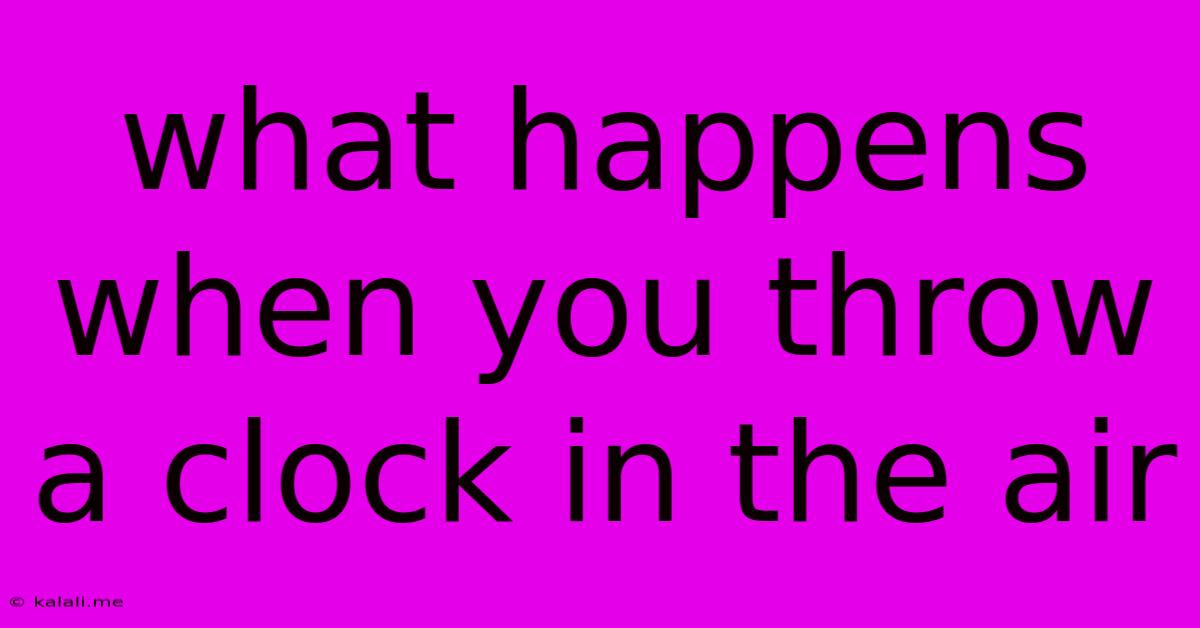What Happens When You Throw A Clock In The Air
Kalali
Jun 03, 2025 · 3 min read

Table of Contents
What Happens When You Throw a Clock in the Air? A Surprisingly Complex Question
What happens when you throw a clock in the air? It seems like a simple question, but the answer delves into fascinating aspects of physics, engineering, and even a touch of philosophy. This seemingly mundane act reveals a surprising amount about gravity, air resistance, and the delicate mechanics of a timekeeping device.
The Initial Ascent: Defying Gravity
The moment you launch the clock upwards, you're working against gravity. The force of your throw imparts kinetic energy to the clock, temporarily overcoming the earth's gravitational pull. The clock's trajectory will follow a parabolic arc, initially accelerating upwards, then decelerating until it reaches its apex. This apex is the point of maximum height, where the clock's upward velocity momentarily becomes zero before gravity takes over again. The specifics of the trajectory—height and distance—depend on the force of your throw, the angle of launch, and the weight and aerodynamic properties of the clock itself.
The Descent: Gravity's Reckoning
As the clock begins its descent, gravity takes center stage. The clock accelerates downwards at approximately 9.8 m/s² (ignoring air resistance for the moment). This constant acceleration means the clock's speed increases steadily as it falls. The duration of the fall is determined by the height it reached at its apex.
The Role of Air Resistance (Drag): A Complicating Factor
Our simplified explanation ignores air resistance, or drag. In reality, air molecules collide with the clock as it moves through the air, creating a force that opposes its motion. This drag force is dependent on the clock's shape, size, velocity, and the density of the air. The faster the clock falls, the greater the drag. At some point, the drag force will equal the force of gravity, resulting in a terminal velocity – a constant speed at which the clock continues to fall. This terminal velocity prevents the clock from accelerating indefinitely. The clock's design—its shape and material—significantly influence the magnitude of air resistance. A larger, more aerodynamic clock will experience higher drag than a smaller, more compact one.
The Impact: A Violent Conclusion (or Not)
The final stage, the impact, depends on several factors including the clock's construction, the surface it lands on, and the speed at which it hits. A delicate, antique clock will likely suffer significant damage upon impact, potentially shattering its glass face or damaging its internal mechanisms. A more robust clock might survive the fall with only minor scratches. The landing surface is also crucial; a soft landing on grass will have a vastly different outcome than a hard landing on concrete.
Beyond the Physics: A Philosophical Interlude
The seemingly simple act of throwing a clock in the air prompts broader reflections. The clock itself, a symbol of order and precision, is subjected to the chaos of uncontrolled motion. This highlights the contrast between human intention and the inherent randomness of the physical world.
In Conclusion: More Than Meets the Eye
Throwing a clock in the air, while seemingly simple, reveals a complex interplay of physical forces and engineering principles. From the initial ascent defying gravity to the descent influenced by air resistance and the eventual impact, each stage offers a fascinating glimpse into the world of physics and mechanics. Next time you consider such an act, remember the underlying scientific principles at play!
Latest Posts
Latest Posts
-
How To Tell If Water Heater Is Working
Jun 04, 2025
-
Does Lux Q Stop Katarina Ult
Jun 04, 2025
-
Unable To Read The Lock File
Jun 04, 2025
-
Whirlpool Washing Machine Not Spinning Fast
Jun 04, 2025
-
And Its Always Good To Be Prepared Than Sorry
Jun 04, 2025
Related Post
Thank you for visiting our website which covers about What Happens When You Throw A Clock In The Air . We hope the information provided has been useful to you. Feel free to contact us if you have any questions or need further assistance. See you next time and don't miss to bookmark.